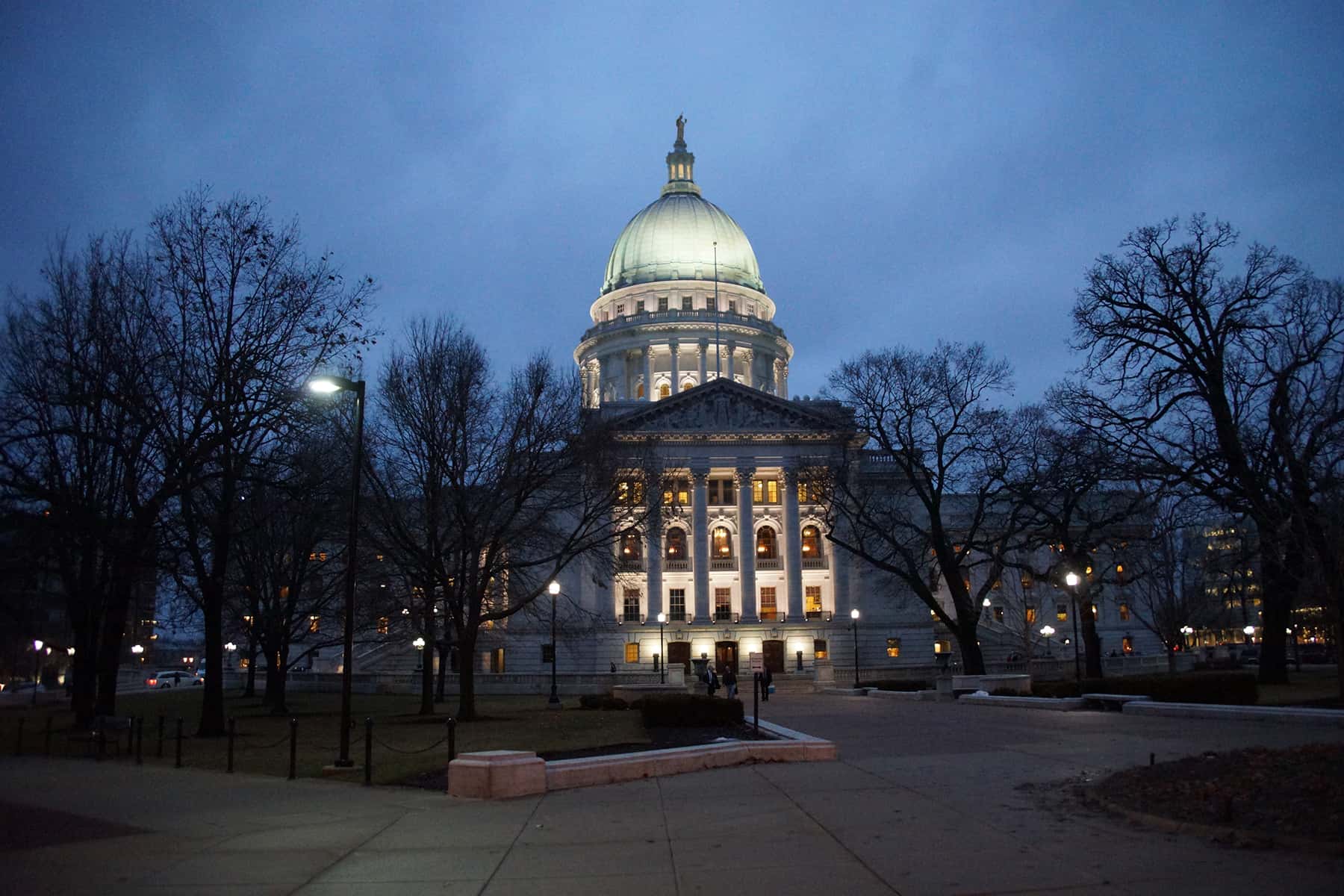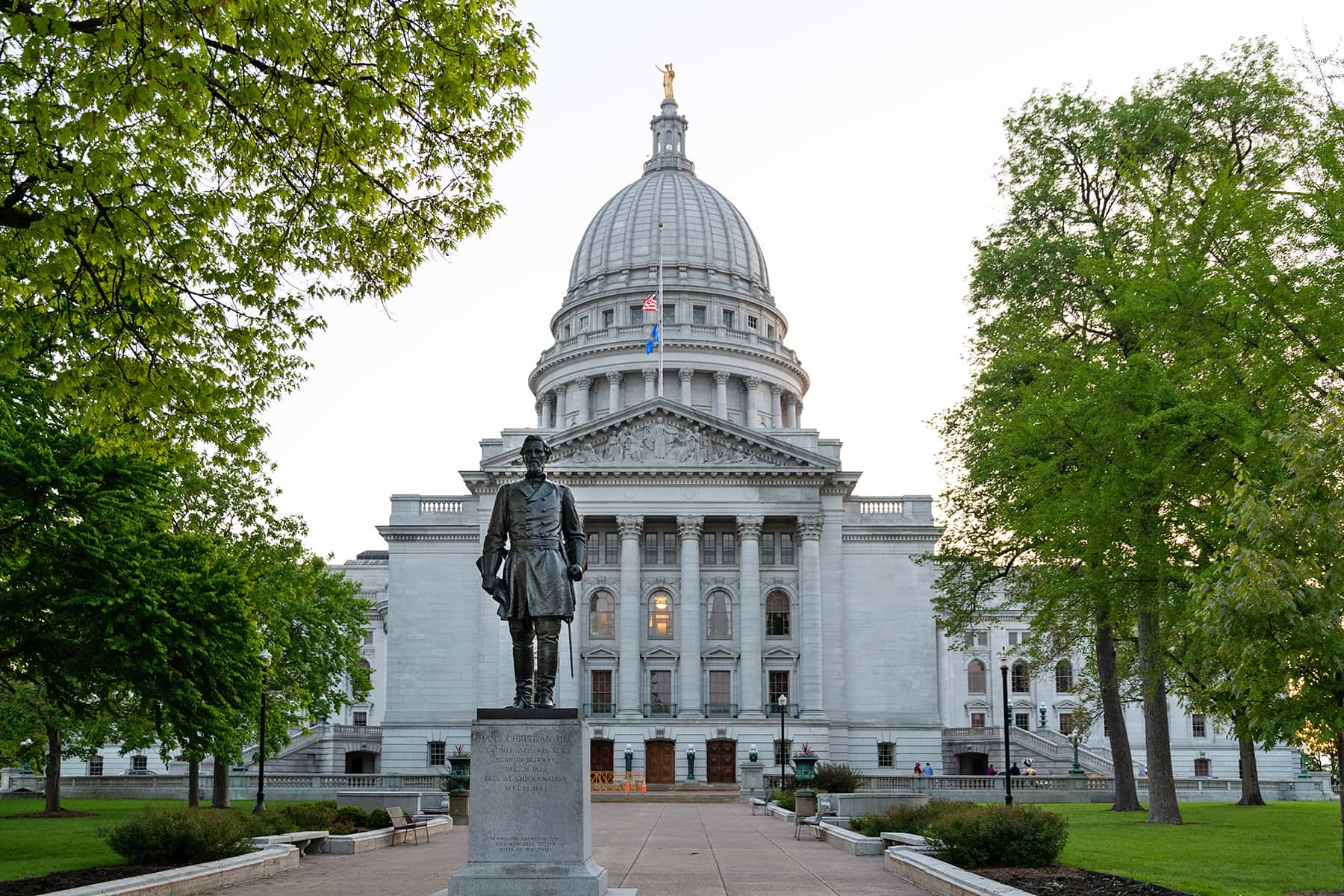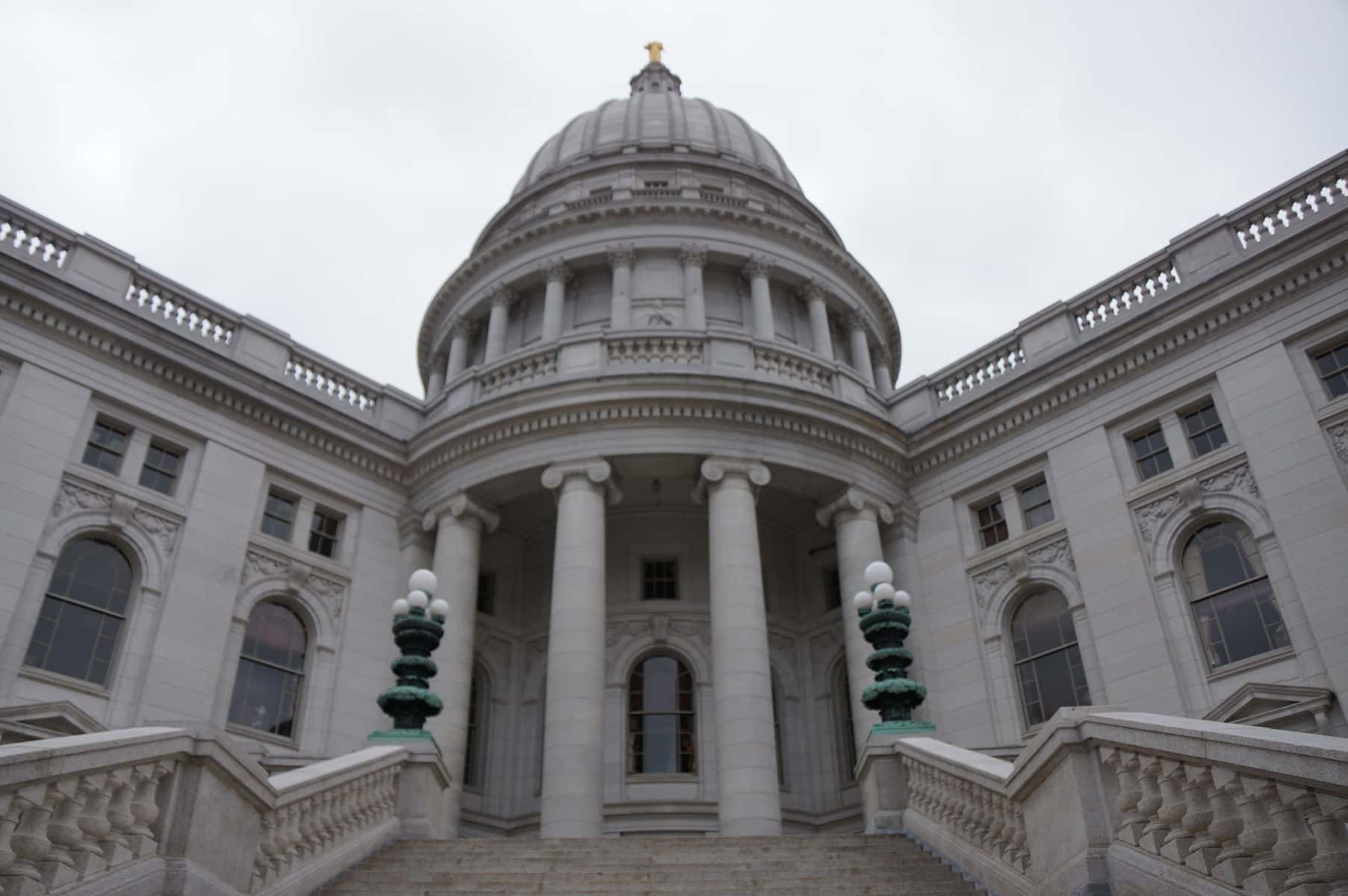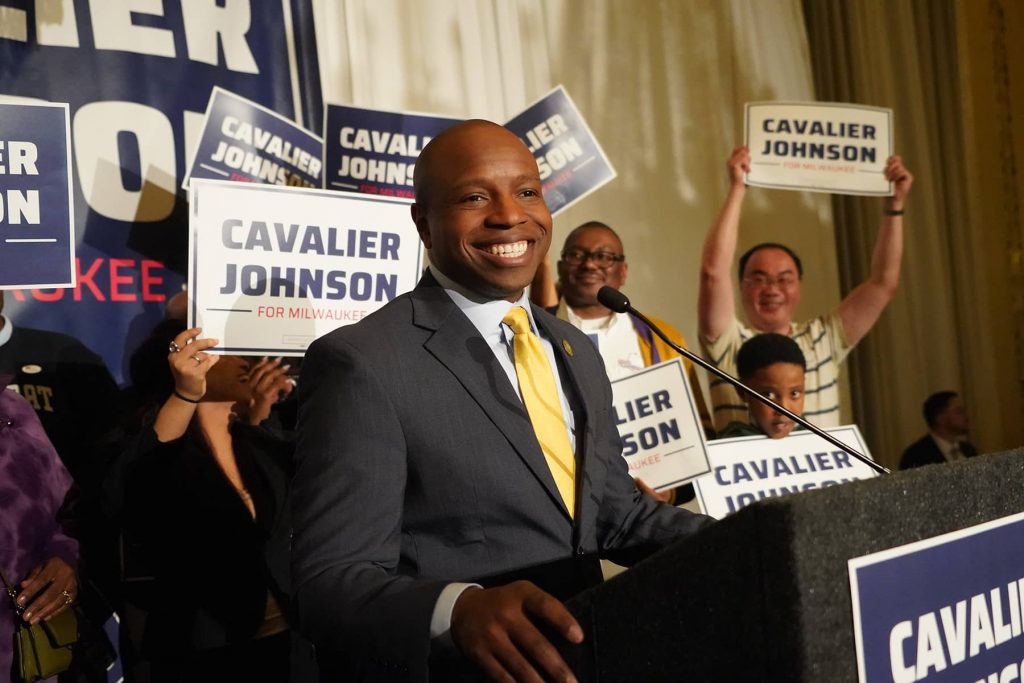
As Wisconsin businesses shuttered this spring to slow the spread of COVID-19, jobless filings and phone calls flooded the state Department of Workforce Development — too quickly for staffers to keep up. But DWD Secretary Caleb Frostman remained optimistic
In a May 4 email, Frostman told Unemployment Insurance Division Administrator Mark Reihl to “hang in there.”
“If we can get through May, I think we will be cooking with gas with all the new people on board and call centers up and running,” Frostman wrote.
Three days days later, Frostman emailed Reihl before a meeting with the state’s Unemployment Insurance Advisory Council: “We have a great story to tell of our staff working themselves to the bone on behalf of claimants and we’ve been putting the pieces in place to build that necessary infrastructure to succeed through COVID.”
Staring down nearly 400,000 unprocessed weekly claims just after Memorial Day, Frostman told a state Senate committee that his department expected to work through the backlog by early October. Now in late November, a still-raging pandemic is threatening an economic recovery and Democratic Gov. Tony Evers has ousted Frostman. Families are still waiting on DWD to process jobless claims filed last spring, with many missing bill payments, racking up credit card debt, facing eviction or worse.
Among those waiting: 50-year-old Karrie Suhr, who worked at a public pool in Cedarburg and was scheduled to work at Milwaukee’s Summerfest when the pandemic hit. She filed her claim in June and has yet to receive benefits, leaving her with no income throughout the summer. During that limbo she learned the cancer she thought she beat had returned.
“I had to borrow money from my family just to pay my own health insurance to make sure that I was covered for all these cancer treatments,” Suhr said. “So that’s been very emotional as far as just — I’ve been paying bills all my life and wanting to have good credit … then something like this happens.”
Wisconsin’s unemployment safety net has buckled under a pandemic stress test. More than 1 million filed initial claims from March 15 to November 7. As of November 14, nearly 93,000 applications for regular and federal pandemic aid had yet to be processed or adjudicated. Thousands more are applying for benefits each day. More than 17,000 initial claims were filed during the first week of November alone.
Ben Jedd, a DWD spokesman, noted that 7.7 million weekly claims have flowed to the department since March 15 — compared to the 7.2 million claims it handled from 2016 to 2019.
“DWD has been dealing with more than four years of work in eight months,” he said.
Wisconsin is not alone in its struggle to distribute jobless aid during the pandemic, but it fares poorer than most states by at least one measure. Wisconsin paid just 42.5% of all initial claims filed between March and August 15 — far below the 56% national average, according to an analysis of federal Department of Labor data by The Century Foundation, a progressive think tank.
Republicans and Democrats have both played roles in Wisconsin’s safety net failures. Party leaders are blaming each other as residents wait.
“There are people who are talking about suicide. Because they’re just waiting and waiting — because the backlog is so bad,” said Victor Forberger, supervising attorney for the University of Wisconsin’s Unemployment Compensation Appeals Clinic, who has represented dozens of jobless clients during the pandemic.
“Landlords are falling behind. The whole economy is going into a tailspin, because the department is falling through. And I worry about folks — and what’s going to happen if fundamental change doesn’t happen pretty soon.”
Limiting benefits access
Millions of Americans who have received unemployment insurance benefits during the pandemic can thank Wisconsin, where a couple who met at the University of Wisconsin Law School conceived and helped pass a 1932 Wisconsin law that laid the foundation of the country’s unemployment insurance system. The effort came as union members, employers and reformers living through the Great Depression realized that charity alone could not sustain workers through economic upheaval.
But the 2020 pandemic struck after Wisconsin and other states spent recent years toughening rules for accessing unemployment benefits — in the name of reducing fraud — and failed to upgrade antiquated computer systems.
Just 32% of unemployed Wisconsin workers accessed benefits in 2016, down from 50% in 2007, according to a 2017 study by the National Employment Law Project, a nonprofit that advocates for low-wage workers and the unemployed. Nationally, the rate of covered unemployed workers fell from 36% to 27% over the same period.
“The systems in various states were at best neglected and at worst sabotaged,” said Michele Evermore, senior policy analyst with the unemployment law group, adding that Wisconsin’s years-long drop in benefits access was particularly large.
Beginning in 2011, the Legislature under then-Governor Scott Walker, a Republican, enacted a series of laws that: created a one-week waiting period for benefits (temporarily waived during the pandemic), increased work search requirements for recipients, disqualified people on federal disability from accessing unemployment compensation and increased criminal penalties for making false statements or representations on applications.
Additionally, Walker signed a lame-duck law just before Evers took office that restricts the governor’s ability to waive certain requirements for state-federal benefits programs including unemployment insurance. The Walker administration also made claims filing more confusing, Forberger said, by removing guidance that helped people navigate the process.
Evermore, who recently joined President-elect Joe Biden’s transition team, said many states have overemphasized reducing access to benefits, slowing down claims processing when people are most in need.
“These systems that have been designed to stop benefits at every corner are now throwing people out left and right,” she said.
Decades-old technology
Also behind the backlog: DWD’s 1970s-era technology, a vulnerability that lawmakers in both parties have understood for decades but never bothered to fix.
DWD planned a major overhaul of its computer system more than a decade ago, but Democratic Governor Jim Doyle’s administration pulled the plug in 2007 as the project — contracted to two outside companies — fell behind schedule and looked poised to exceed its $24 million budget.
The department’s IT system requires sequential testing and programming, meaning that new benefits programs — such as those adopted by Congress during the pandemic — must be programmed one at a time, delaying claims processing.
“One of the most glaring lessons learned coming out of the Great Recession — which went unaddressed by previous administrations — was the desperate need to modernize the unemployment insurance base benefits system, yet Wisconsin is still saddled with one of the most antiquated and inflexible systems in the country,” Jedd said.
DWD reached out to at least five companies in 2019 to demonstrate replacement software, public records show. Cost estimates ranged in the “tens of millions of dollars,” Jedd said, and DWD was exploring a funding strategy when the pandemic halted its progress.
State Representative John Nygren, R-Marinette and co-chair of the Joint Committee on Finance, has criticized Evers’ DWD for not formally seeking funding to overhaul the system in its most recent budget request.
While the department did not specifically make such a request, Frostman, in a September 15 letter accompanying the budget request, vowed to work with Evers’ office “to develop an appropriate UI modernization funding strategy throughout the budget process.”
Speaking to reporters in late-September, Evers said DWD was still evaluating an upgrade plan.
“And I am really happy to have Rep. Nygren behind this, because we desperately need it.”
Nygren said that Republicans are open to funding a computer system upgrade, though he would not concede that the department’s failures were rooted in the old technology. Nygren said Evers was raising the issue as a “red herring” to distract from other mismanagement during the pandemic.
“Let’s move forward. If that’s no longer the problem — if we could check that off the box, let’s identify the other things that are continuing to be a problem,” Nygren said.
Online headaches
Meanwhile, DWD’s shift to online-only claims filings have created headaches for some residents, said Forberger, the unemployment lawyer. Beginning in 2017, DWD began requiring most claimants to initially file online and retired an automated phone system for filers. That was after a 2014 audit found that DWD call centers automatically blocked 80% of calls during times of high volume.
Nygren said the focus on online claims “made the system better, and actually helped get more applications through the process in a seamless way.”
But the singular option to file claims online can be a problem in a state where 43% of rural areas lack broadband coverage.
“You have technological hurdles galore,” Forberger said, which increases the risk of mistakes that lead to denials. “People have to do a lot of stuff on their smartphones. The system isn’t well designed for smartphones.”
Suhr, the Cedarburg woman, said she is unsure what is holding up her claim, which two adjudicators long ago said was settled.
In an October 28 interview, she read a message posted to her online claims portal: “One of these decisions requires additional processing by our central office. Processing normally takes less than two weeks. This message will be removed when processing is complete.”
The message had appeared eight weeks earlier.
Anatomy of a disaster
DWD staffers worried about the department’s image and urgently sought to fight through the backlog as the crisis escalated this spring, according to emails obtained through an open records request.
“Social media is becoming a bigger and bigger problem,” DWD spokesman Ben Jedd wrote to a colleague on March 26, the day after Evers’ Safer at Home order shuttered businesses. “We are getting more and more questions and negative comments on Facebook and Twitter.”
Jedd suggested setting up an email box for people struggling to reach staffers over the phone and designating an expert to answer questions over social media — as many other states had done.
“People are used to using email and social media to get their questions answered and we may need to reevaluate and modernize some of communications,” he wrote.
Later that Thursday, Frostman wrote to Reihl, the unemployment insurance chief: “We are getting inundated with press inquiries about the long wait times and we can only keep the negative press at bay for so long.”
He added: “I know your team is working hard and doing the best they can within the constraints of the current infrastructure, but we have to find a way to get more answers to more people.”
Frostman wrote that Evers’ team had “voiced their willingness” to shift staff or other resources to the department. The administration did not reshuffle employees until May, according to staffing records.
Call centers ‘doomed from the start’
Wisconsin spent at least $21.2 million through September on contracts to expand DWD call centers and staff for claim adjudication and processing — in some cases forgoing competitive bidding to speed the process, according to department data. The unemployment insurance division also spent nearly $1.2 million in employee overtime, 10 times levels spent in 2019.
DWD initially assigned unemployment insurance experts to answer emails and social media questions, Jedd said. An online chatbot and Frequently Asked Questions posting eventually answered most general questions. Over time, however, email and social media inquiries largely involved individual cases, Jedd said, requiring staff to call claimants and verify their identities before answering questions over email.
Residents — many of whom had never before navigated the unemployment system — overwhelmed DWD phone lines. From mid-March through June, DWD call centers answered just one out of every 200 calls, according to a Legislative Audit Bureau report released in September. About 93% of 41.1 million calls were blocked or prompted busy signals, while frustrated callers abandoned an additional 6.2% of calls.
The call centers were “doomed from the start,” Forberger said.
“If the whole focus is online claims only, and you’ve made this system incredibly complicated and impossible to use, then of course — people are gonna start calling up, because they don’t understand.”
In a letter responding to the audit, DWD Deputy Secretary Robert Cherry, Jr. wrote that wait times and rate of unsuccessful calls began to plummet in July as the agency expanded call center capacity. DWD through September spent more than $14.6 million on call center staff from two outside firms: Alorica, a global company, and Milwaukee-based Beyond Vision, a nonprofit that hires people who are blind or visually impaired.
Nearly $12.6 million went to Alorica, which in 2019 shuttered a Green Bay call center and laid off 157 workers while shifting many U.S. positions overseas. The company’s DWD contract called for 500 phone operators. Alorica began answering calls in May but was not fully staffed until July 19, according to the Legislative Audit Bureau.
“After updating our systems and onboarding the additional call center vendor staff, almost all calls have been answered on a daily basis,” Jedd wrote in an email.
Some jobless residents questioned the effectiveness of call centers even when calls reach an operator.
Callers might luck out and get a useful answer, said Chenon Times-Rainwater, a 41-year-old small business owner in West Bend, Wisconsin, who organized a support group for unemployed residents after waiting two months on her claim. “Or you would call, and you would get transferred and transferred and transferred. And it would be a three-hour situation, and you would get nowhere.”
DWD through Wednesday added 681 call center workers, including new hires and shifts between departments and divisions, records show. The department added a smaller number of adjudicators and claims processors who could actually work through glitches: 525.
“Staffing up the call center was an important first step so that claimants were able to ask questions and receive assistance in filing their initial claims,” Jedd said.
Said Times-Rainwater: “It tells me that they spent a lot of money for no progress.”
Frostman ousted
Evers in mid-September asked Frostman to resign as secretary, citing the claims backlog.
“People across our state are struggling to make ends meet, and it is unacceptable that Wisconsinites continue to wait for the support they need during these challenging times,” he said in a statement at the time. Evers also blamed Republicans for making it “harder for folks to get these benefits.”
Frostman told said early this year that he understood frustrations with the department as it worked through obstacles.
Department of Corrections Deputy Secretary Amy Pechacek has assumed Frostman’s role until a new secretary is appointed.
In search of solutions
A group of Democratic lawmakers in July unveiled legislation to overhaul the state’s unemployment system. The bills would: reverse a ban on benefits for people on federal disability who lose part-time work; permanently eliminate a one-week waiting period for benefits; ease work search requirements; and repeal a Walker-era law that eliminated benefits for workers dismissed for “substantial fault” — a violation less serious than misconduct on the job.
One of those Democrats, Senator Chris Larson of Milwaukee, said his colleagues also want to simplify applications to reduce instances of simple mistakes being flagged as fraud.
“We’ve had too many neighbors across the state who had to wait weeks and in some cases months to be able to get assistance,” he said.
Larson expects to formally introduce legislation in January when lawmakers return to Madison.
The Republican-controlled Legislature has drawn criticism for doing little to address the claims crisis — or the pandemic. It has not passed a bill since a COVID-19 relief package on April 15, making it the least-active full-time legislative body in the country, according to a WisPolitics.com analysis.
“It’s one of those issues that I think they thought that this will just fix itself,” Larson said. “It’s like the ‘check engine’ light that shows up on your car, and you just kind of hope that it’ll just resolve itself.”
Nygren and fellow Republicans argue Democratic proposals to ease restrictions on benefits could open the door for fraud. They have instead unsuccessfully called on Evers to use $40 million in federal pandemic stimulus funds to offer low-interest, forgivable loans to people waiting on jobless benefits. (Loan applicants under the program would not face the type of restrictions that Republicans put in place for unemployment claims to deter fraud.)
The program would serve only a fraction of those with 93,000 claims still pending or in adjudication, according to a Legislative Fiscal Bureau memo, depending on the size of individual loans. About 10,800 people could get loans of roughly $3,700, for example, or 30,600 could get about $1,300.
As residents await any substantial fixes to Wisconsin’s unemployment insurance woes, Forberger said DWD should follow the lead of states such as Massachusetts, which in March began holding virtual town halls to explain unemployment insurance bureaucracy. That state delivered benefits to nearly 72% of more than 1 million initial claimants from March to August — a far higher rate than in Wisconsin, according to Century Foundation analysis.
“Why isn’t the department doing something like that? They have the technology. They made everything online,” he said. “Why can’t they answer people’s questions?”
In Cedarburg, Suhr now has some income trickling in after starting part-time work at a local school this fall. But it’s not enough to pay the medical bills that began piling up in April as she continues to wait — and hope — for compensation from the state. She expects more folks to feel similar frustration in the coming months.
“This isn’t going away,” she said. “COVID is getting worse, and I feel like more and more people are going to probably be applying for unemployment.”
Marty Hobe and Bram Sable-Smith
Lee Matz
The nonprofit Wisconsin Center for Investigative Journalism collaborates with Wisconsin Public Radio, Wisconsin Public Television, other news media and the UW-Madison School of Journalism and Mass Communication. All works created, published, posted or disseminated by the Center do not necessarily reflect the views or opinions of UW-Madison or any of its affiliates.
















